The LG G4 Review
by Joshua Ho on July 30, 2015 10:00 AM EST- Posted in
- Smartphones
- Qualcomm
- LG
- Mobile
- Snapdragon 808
- LG G4
Battery Life/Power Analysis
Battery life continues to be one of the most important aspects of any mobile device. It can often make or break a device, especially when flagships these days are increasingly designed to represent the best of all worlds for an end user. As a result, there will always be a need for battery life tests as smartphones continue to last around a day or two at best.
In order to test this, we turn to our standard suite of battery life tests that test for the most common use cases in a smartphone. In order to ensure that we’re making proper relative comparisons, we also calibrate all devices to a standard 200 nits to make sure that we aren’t unfairly penalizing a device based how an OEM decides to set their brightness curve on a percentage scale. For 2015, we’ve added the PCMark battery life test, which attempts to find a middle ground between the strongly display-bound web browsing test and the almost purely SoC bound throttling tests.
Normally, we'd dive straight into the battery life analysis. However, in the interest of providing some extra context to our battery life results we'll start by looking at display power, which will allow us to get a good idea for what exactly is affecting battery life. However, it's important to understand that the display is affected by Content-adaptive backlight control (CABC), which will reduce the backlight power and reduce gamma in order to attempt to reduce power consumption. This means that tests like PCMark and GFXBench will have a lower display power component than would be expected from the following power measurements.
In order to obtain these values, we set the brightness to meet a certain value at the approximate center of the display, then disabled all possible applications, enabled airplane mode, and set the display to show a full white image while idling. Measurement of power was taken at the fuel gauge ten times a second over the course of at least 30 seconds, and between each recording period the phone was placed in deep sleep to alleviate issues with die temperatures affecting power readings. Once we do this, we get the following results.
As one can see, the minimum brightness of ~4 nits has an idle power consumption of 519 mW. This is somewhat concerning, as despite the use of panel self-refresh (PSR) on LG's part, idle power consumption is still easily around double that of the HTC One M8. However, to LG Display's credit the 1440p display of the G4 is efficient and decreases the 161 mW deficit that it starts with relative to the Galaxy S6 down to 55 mW by the 200 nit mark and keeps going from there. Given that power scales linearly with brightness it's likely that brightness scaling is simply accomplished by PWM (pulse width modulation) similar to AMOLED devices that we've examined. Comparing this to our previous review in which we found that the G3 uses 1415 mW (or 560 mW more) on a blank white display at 200 nits, and it's clear that LGD has made some enormous improvements to power efficiency over the course of a year.
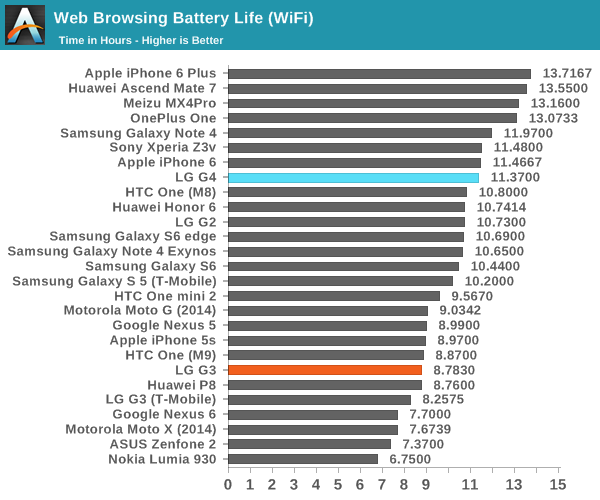
Our first test is web browsing, and here the LG G4 manages to surprise. A combination of a much-improved display and a well-implemented SoC on TSMC’s 20nm process seems to have solved most of the penalty that comes with a 1440p display with RGB stripe.
Battery life in this scenario isn’t quite as good as devices like the OnePlus One, although I suspect in practice SoC and modem efficiency will be more heavily weighted than it is in this test. We can actually see that the display is the main contributor to power consumption here, as if we assume that the battery has the typical 11.6 WHr capacity, this means that the average power consumption past idle display is 165 mW. Comparing this to the LG G3 (which has brightness reduction) means that on average the G4 reduced power consumption by about 442 mW, which suggests that the SoC has either unchanged or reduced power efficiency relative to Snapdragon 801 in this test although absent proper testing (not with a fuel gauge or at a power outlet) it's hard to say for sure here.
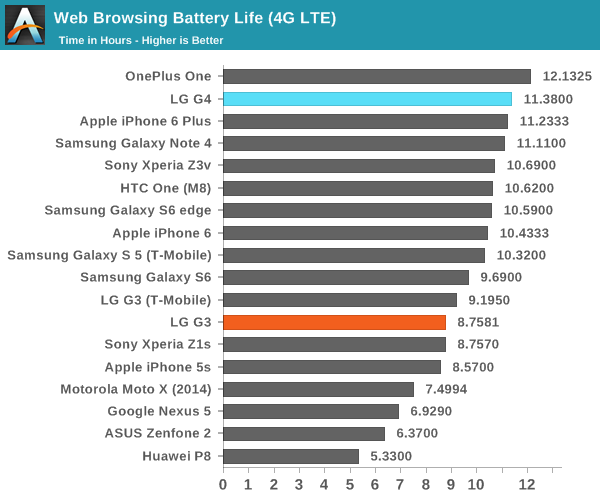
In LTE web browsing, we can really see the value of Qualcomm’s modem, as with Snapdragon 808 LTE web browsing is effectively identical in battery life to WiFi web browsing. There’s been a lot of talk recently of companies displacing Qualcomm in the modem space but it seems that for high-end devices Qualcomm remains the best choice when accounting for power efficiency of modem implementation. Unfortunately, the details of how Qualcomm pulls this off are a closely guarded secret, so all we really know is that a combination of better modem code, modem architecture, standards implementation, and layout contribute to Qualcomm’s lead here.
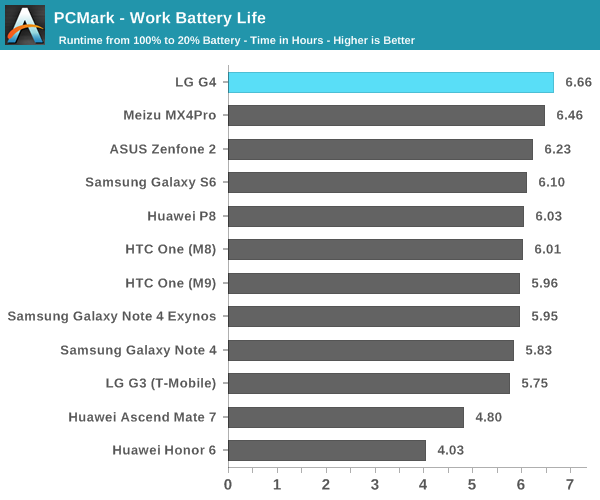
Moving on to more SoC-bound tasks, we can take a look at PCMark first. Here, we see that the LG G4 manages to significantly improve over other devices like the HTC One M9 in both runtime and score throughout the test, which definitely suggests that there is a noticeable perf/W delta between S808 and S810. Given the difference in performance, it's probably fair to say that the total work done is comparable between the Galaxy S6 and G4, but the G4 has a larger battery relative to the display size.
Now that we’ve looked at battery life through a suite of everyday tasks that tend to be display-bound or balanced between SoC and display, we can look at SoC-bound tasks that are either focused on the CPU or GPU.
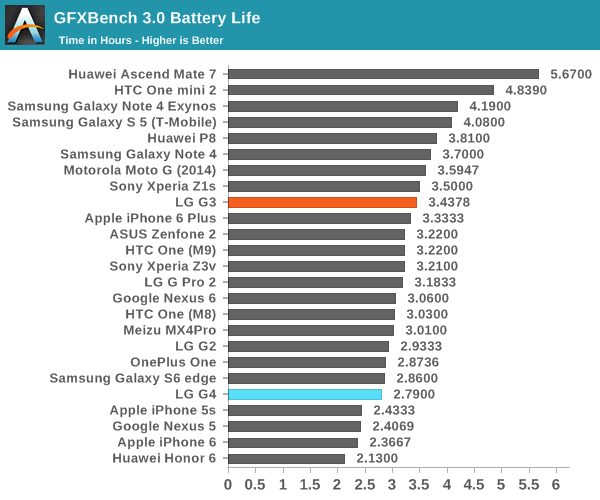
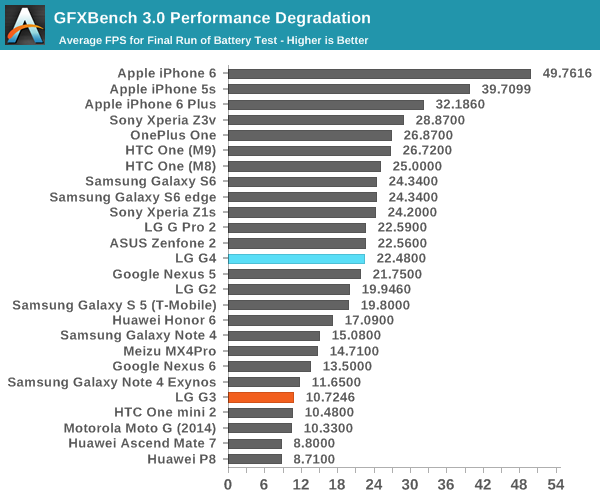
In GFXBench, we can see significant advantages from LG’s choice of the Snapdragon 808 SoC over the Snapdragon 810. The runtime ends up noticeably shorter than something like the One M9, but the frame rate is far more consistent and relatively higher than the M9 accounting for the higher rendering resolution, although I'm not sure whether it makes sense to have this sort of sinusoidal GPU performance outside of compute/race to sleep workloads. In sustained workloads it appears that the Adreno 418 is effectively comparable to the T760MP8 of the 7420 despite the process node advantage of the Exynos 7420. Given that the on-screen content of T-Rex is relatively low in average picture level, the AMOLED display accounts for at least some of the deficit between the GS6 and G4 in this test as well.

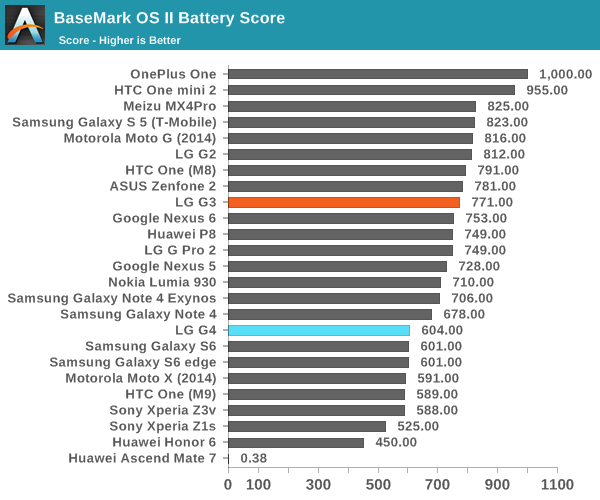
In Basemark OS II, we continue to see why LG has chosen to go with the Snapdragon 808. Although the battery performance is comparable to the One M9 here, in practice sustained performance is higher as the test manages to stay on the A57 cluster at around 800-600 MHz rather than dropping off to the A53 cluster from thermal throttling. The Galaxy S6 is still the winner here as it can keep two extra A57s at around 1-1.2 GHz in this test, but once again it’s important to emphasize that Qualcomm has a pretty significant process disadvantage here due to the use of planar transistors and a larger feature size. We’ve discussed the advantages of FinFET before in articles, and those interested in learning more can refer to our introduction to the topic, but the key here is that FinFET and other multiple-gate technologies are really the key to driving better performance.
Overall, the LG G4’s battery life is worthy of praise. In everyday use battery life is comparable to the Galaxy S6, and display-bound, high APL tasks will see a noticeable advantage over the Galaxy S6. In compute-bound tasks the G4 does lag behind the Galaxy S6, but the gap is nowhere near as large as it is with Snapdragon 810. Obviously, there will be some performance deficit due to the weaker GPU and fewer big CPU cores, but given the battery life advantages it seems LG has made the right trade-off here. It's also interesting to see here how in the G3 the SoC was making up for an efficiency deficit while in the case of the G4 the display seems to be making up for the SoC's efficiency deficit.
Charge Time
Although battery life is usually the most important aspect of staying mobile, charge time is often the other side of the equation and in any situation where minutes count charge time directly influences the effective runtime. There are a number of obvious situations where people can forget to charge their phones or are otherwise unable to charge their phones ahead of time. I’ve definitely had cases where I either forgot to put my phone on the charger before I went to sleep, or I had thirty minutes to charge my phone before a long flight.
In order to test this kind of use case, we look at how fast it takes for the phone to charge from 0% to 100% using the included charger. In the case of the G4, this means a 5V, 1.8A charger. However, it seems that the variants of the G4 on sale now will support Qualcomm’s QC 2.0 which could bring down charge times if the included charger isn’t enough. In order to test this, I monitor power at the outlet logged once per second to see the point at which charging corresponds to 100% charge to find the total time.
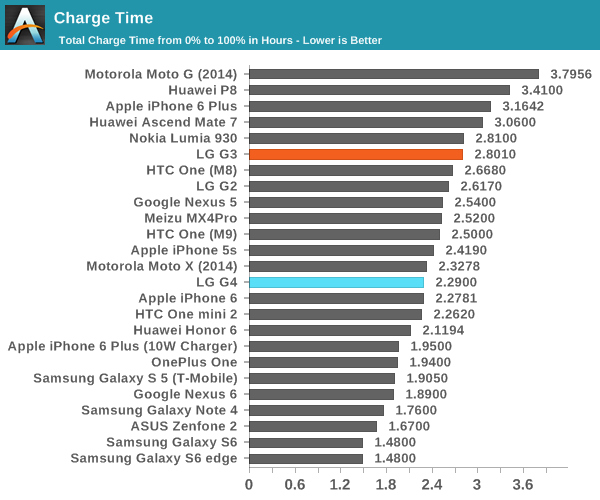
With the standard 5V, 1.8A charger the LG G4 posts a rather standard 2.29 hour charge time. This isn't quite as fast as some other devices that use 9V charging to enable fast charging, but it's definitely not a major issue given that the G4 has good battery life. As far as I can tell, the units that I have don't support QC 2.0 but given LG's statements that QC 2.0 will be supported it should be available on other units, although I'm not sure if LG will support anything higher than 9 volts at 1.3 amps.


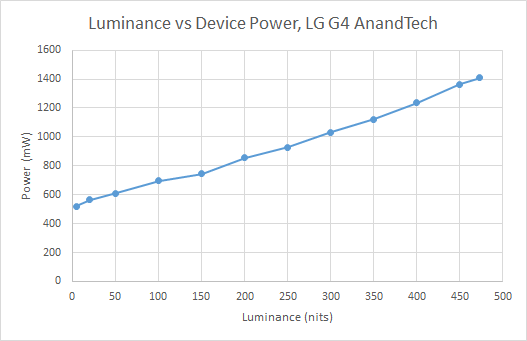
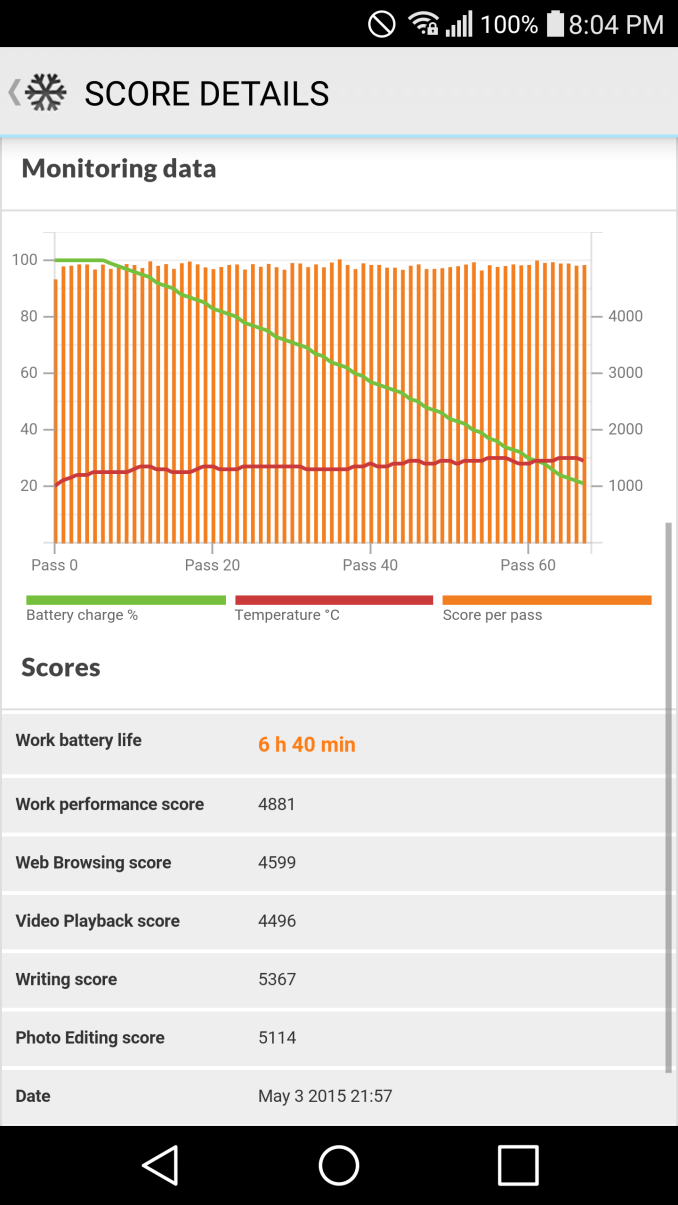
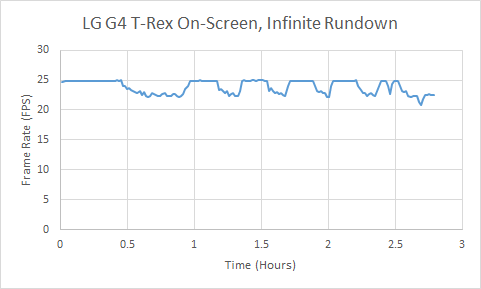
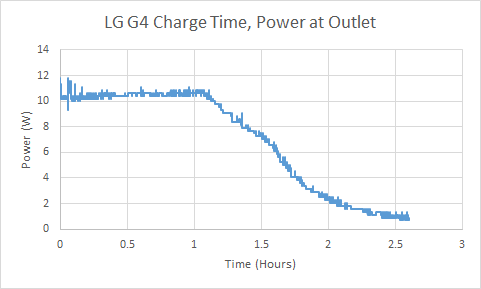








84 Comments
View All Comments
hans_ober - Thursday, July 30, 2015 - link
Throttling compared to S810?JoshHo - Thursday, July 30, 2015 - link
Definitely less. S808 spends more time at higher frequencies than S810 even after 20 minutes.hans_ober - Thursday, July 30, 2015 - link
Thought I'd see a AT deepdive (a whole page :) ) on S808 vs S810.. especially what S808 loses compared to S810 (memory, GPU, CPU ) and throttling, perf vs time.JoshHo - Thursday, July 30, 2015 - link
I definitely hope to do that at some point.hans_ober - Thursday, July 30, 2015 - link
Thanks a ton!LoganPowell - Friday, November 27, 2015 - link
The L3 G4 is really good, however the Moto X Pure Edition is rated slightly higher (see http://www.consumerrunner.com/top-10-best-phones/ for example), so I would consider that one instead if I were you.ThisIsChrisKim - Thursday, July 30, 2015 - link
Looking forward to it :)niva - Thursday, July 30, 2015 - link
I was also expecting to see some sort of a technical comparison here related to the SD 808 vs. the SD 810. I for one also think the 1440 screen is overkill, especially in a sub 6" device using the SD 808.On the final page you went on to say the G4 and the S6 have a camera somewhat comparable to the iPhone 6+... and there you totally lost me. This is one of the things Anandtech can do without in the reviews, the iFanboyism.
BMNify - Friday, July 31, 2015 - link
@niva: Quit trolling Android fanboy, Anandtech and Josh are not ifanboy, they are stating the truth here, you can critic Apple for less ram or restrictive ecosystem but the latest iphone camera is amongst the best, only high-end Lumia phones can challenge or best Apple in this regard.bleached - Sunday, August 2, 2015 - link
Apple isnt rate in the top 5 best smartphone cameras (they haven't tested the G4) and Lumia isn't even close. This is from a camera specific website.